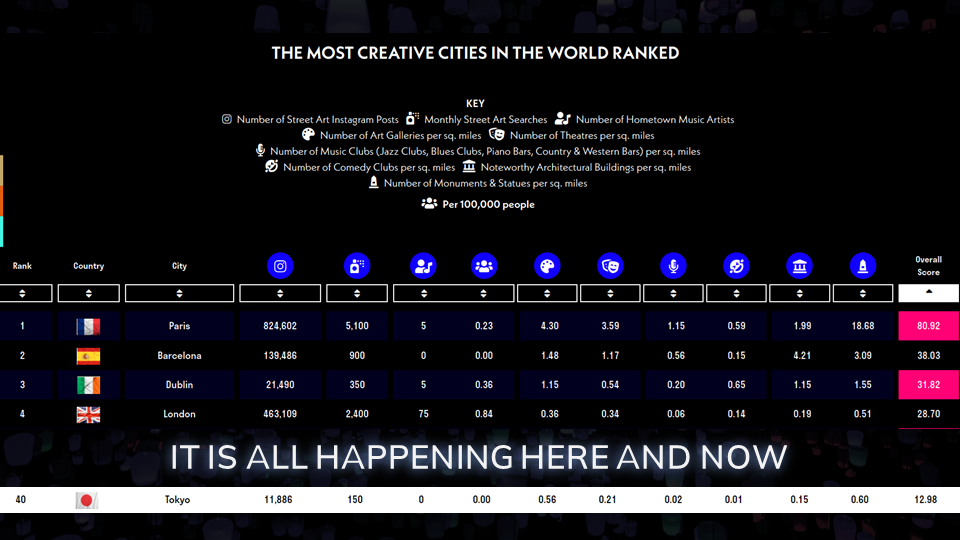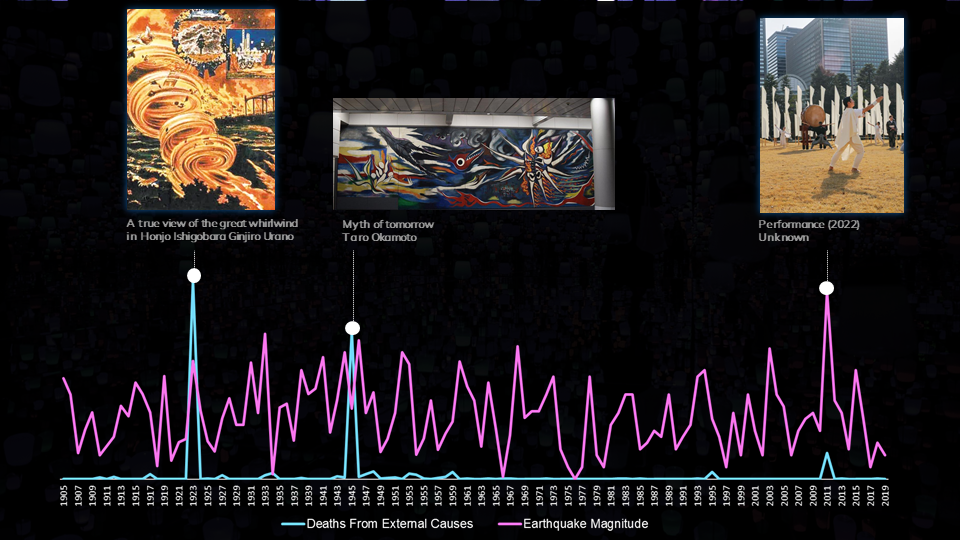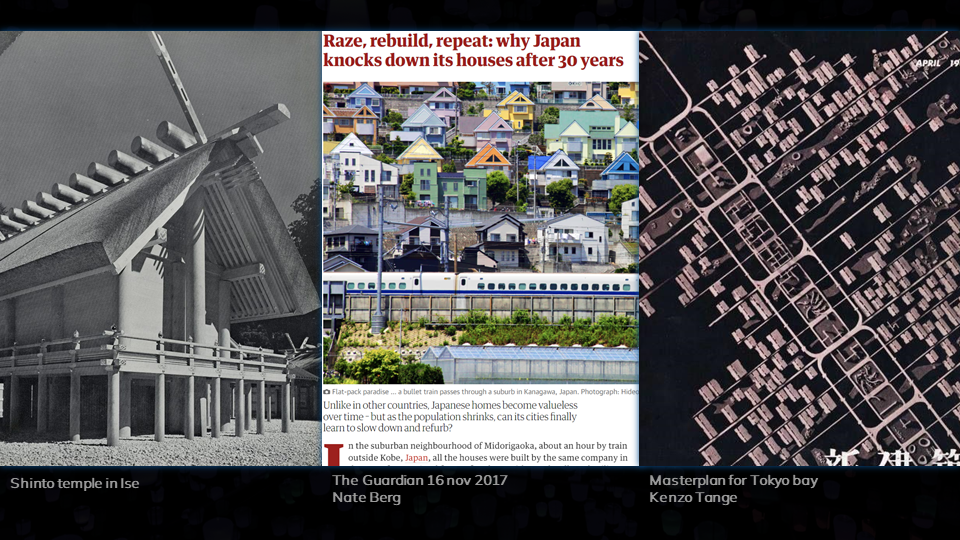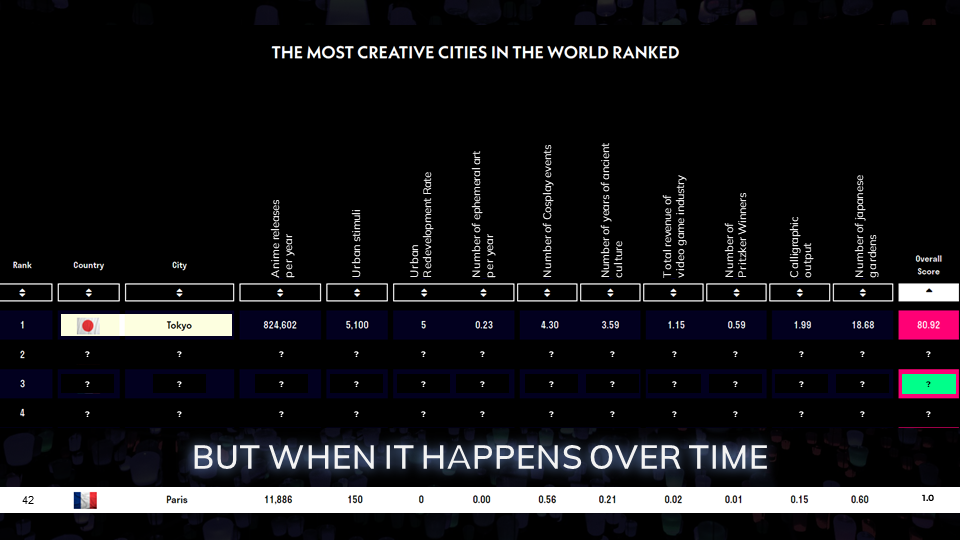Creativity is often seen as the ability to transcend traditional ideas, rules, patterns, and to create meaningful new ideas, forms, methods, interpretations. But, can we confine its vastness to mere definitions? Furthermore, can the creative output of cities be quantified? A notable attempt to do so was made Inkifi. They composed a data based ranking based on the following categories:
- Number of instagram posts of street art
- Number of art galleries per sq mile
- Number of theaters per sq mile
- Number of comedy clubs per sq mile
- Noteworthy architectural buildings per sq mile
- Number of monuments and statues per sq mile

Surprisingly, the ranking places Tokyo, a city pulsating with creativity, at 40th. This intrigued us as we all perceived Tokyo to be one of the top creative cities from our perception and It prompts us to question: Can data truly capture the essence of creativity? Is data enough to make conclusions when it comes to certain topics, subjectivity of the human experience is lacking from the data as well as different layers of a city that are not perceived from an urban scale. Could different ways of gathering data be more accurate in representing the actual information?
Tokyo is a city with an unusual relationship to time and memory, largely due to the continuous waves of destruction that is has suffered. Material memory is generative in contrast with the static western cannon. The urban tradition is one of plugging, playing, replacing and urban revolution. How does artistic memory express itself in such a volatile context? How is creative identity produced and shaped


Tokyo and Japan has a material culture that is much more aware of time than for instance the western culture. It is the home of the Shinto religion where it is a common practice to rebuild shrines and temples at regular intervals. For instance, the Ise shrine has been rebuilt according to the same design every 20 years for the last 1300 years. This religious custom is a practical reaction on the earthquake prone region that Tokyo is built in. In fact, houses in Japan are typically designed for shorter lifespans than in other countries. In this context Tokyo became the scene for the development of the metabolist movement in the 1960s. The metabolist movement was an architectural movement, inspired by the idea of organic growth and adaptation. The metabolists envisioned megastructures that could accommodate changing needs and environments. Their radical imaginaries are products of the volatile and regenerative character that the urban fabric of Tokyo is continuously undergoing. These examples highlight the fact that Tokyo has been forced to be creative in the light of continuous destruction and that its artistic output has a unique character that is coloured by this context.

There are many aspects of Tokyo’s creativity that do not make it to Inkifi’s ranking. For instance: Tokyo is a city with the most Pritzker prize winning architects. It is the home of anime, cosplay and is a major hub in the video games industry. The streets of Tokyo are a continuously evolving led powered canvas of innovation. The image of Japanese culture is one that has become a global point of reference. Tokyo, with its juxtaposition of ancient traditions and futuristic visions, challenges our perceptions. From the meticulous craftsmanship of its artisans to the boundary-pushing designs of its architects, Tokyo’s creativity transcends data.
What if we could imagine a new ranking, one that considers the intangible, the emotional, the temporal. A ranking to Tokyo’s idea of creativity, with factors ranked such as urban redevelopment, innovation and technology, Where might Tokyo stand? if we rearrange the rankings… Tokyo takes the lead as the number one city for creativity!

This critical exercise demonstrates the inaccuracy of utilizing rankings to measure and compare creativity in cities. An effort to quantify “creativity” is a methodology that needs to take into account the most subjective, and local elements of each city, as well as take into account the external factors that have transformed cities throughout the years. Hence ranking the cities on the basis of parameters that add value to their identity is vital. However, these parameters will never be the same for all the cities in the system of ranking and data might not always be the best tool to rank cities creativity.

